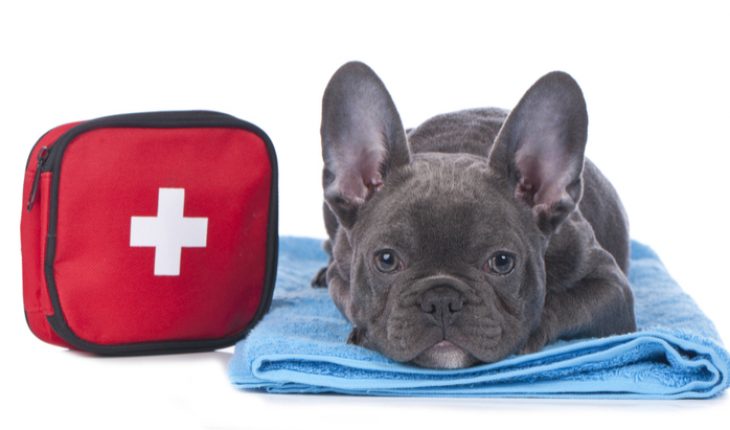Why learning first aid for your dog is so important: Dogs are inquisitive creatures. They are always chewing on things they shouldn’t be eating, getting into unsafe situations or getting into places they shouldn’t be exploring. Sometimes their curiosity leads to an emergency.
There are many emergencies that may arise at home or out on a walk involving our pets. In those moments it is important to be fully prepared in order to act quickly and effectively.
Everyday pets at home eat toxic food or chemicals, injure themselves on something sharp, choke on something or run across a road to be hit by a car. It is vital that they receive prompt and appropriate first aid in any of those eventualities. Surprisingly few owners and pet carers are up to speed with pet first aid.
Unfortunately, it is unlikely that the vet is available to help quickly enough in these urgent situations. Therefore, it is vital to have the proper knowledge and skills to react in these situations. Prompt and appropriate first aid can prevent a minor injury becoming a major one. It can reduce pain, improve outcomes and give you peace of mind that you can do the best for your pet.
For many people their dog truly is their best friend so, should their canine companion need medical help, having the security of having completed a dog first aid course can prove to be invaluable.
Learning first aid
First Aid for Pets runs both online and practical courses that cover all the key aspects of dog first aid. For example how to care for an unconscious dog to commonly occurring injuries and illnesses such as choking, bleeding, fitting, poisoning and much more. The practical courses are run in small groups, with hands-on experience using a specially designed dog manikin and numerous other practical training aids. Many ‘pet parents’ benefit immensely from the courses, but they aren’t just for dog owners. First aid courses are an invaluable differentiator for those working in the in industry as dog-walkers or groomers, as they can be a great way to demonstrate your knowledge and skills in dog first aid to enhance your authority and encourage new and potential clients to feel confident trusting their pets to your care.
First Aid for Pets was featured in the Times – click here to read an unbiased view of one of our courses
Recognising an emergency
If you are worried, always call your vet for advice.
A key point for first aid is learning to recognise an emergency. Here are some emergency situations where you should definitely take your dog to the vet:
If they:
- aren’t breathing or are having difficulty breathing
- are unresponsive
- have collapsed and can’t get up
- are having a fit/seizure
- may have broken bones
- are having difficulty moving or coordinating movements
- may have eaten something toxic
- have been vomiting or passing diarrhoea for more than 24 hours.
Click here to read our article on What the Vet Needs to know in an emergency
Click here for a dog CPR first aid course
Know your dog:
Changes in behaviour such as change in appetite, bowel movements and even smell can indicate that there is something seriously wrong with your pet. Know the key indicators to look out for so that you can act quickly.
Know how to check for a pulse:
The easiest place to find the dog’s pulse is in the upper third of their thigh. Place your hand over the top of their thigh and gently squeeze your fingers just underneath their leg. You should be able to feel the artery pulsing at this point. Your thumb has a strong pulse itself so don’t use this to take their pulse, otherwise you will be timing your own pulse rate! Time the pulse for 15 seconds and then multiply the result by 4 in order to calculate the number beats per minute.
Know how to muzzle your pet:
Even the gentlest dog is likely to bite if it is frightened or in pain, so you should know how to make a makeshift muzzle for them. Remember though – human safety always comes first! You should never muzzle an animal that is overheated (as they will need to pant to cool), that is having difficulty breathing or is likely to vomit. Click here to read a step by step guide as to how to create a comfortable and safe improvised muzzle for your pet.
Know how to help your choking dog:
Choking occurs when something blocks the airway. When the airway is partially blocked a dog may start retching, pacing back and forth and pawing at their mouth. If their airway becomes totally blocked, they will be unable to make any sound at all. Dogs can choke on anything, from plastic bags, balls, socks, toys or anything they can get hold of, if it goes down the wrong way it may leave them unable to breathe. It is important that you spot these signs and then know how to act fast to dislodge the obstruction. Click here to read a guide on how to help your choking pet.
Know how to administer CPR:
If your dog has stopped breathing, call a vet straight away. You may need to perform CPR to increase your dog’s chances of survival. Click here to read how to give your pet CPR.
We hope you’ll never need this advice, but it’s best to be prepared just in case.
Finally being prepared for emergencies could save a pet’s life
Keep your vet’s name, address and telephone number stored in your mobile phone, your landline, and kept in an address book or safe place around the home.
Call your vet first. You’ll need to let them know there’s an emergency case on the way and follow any instructions you’re given e.g. if emergencies are seen on a different site. Keep a pen and paper handy to take down any important instructions from your vet.
Always carry a pet first aid kit with you in case your pet needs your help.
- Gut microbiome could delay onset of type 1 diabetes - 3rd April 2025
- The da Vinci 5 Robot Is Set To Transform Bariatric Care: - 31st March 2025
- Beyond money: the hidden drivers fuelling child food insecurity - 31st March 2025






